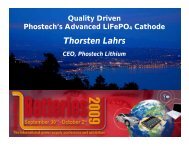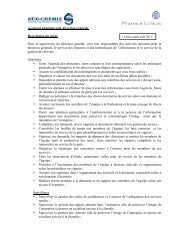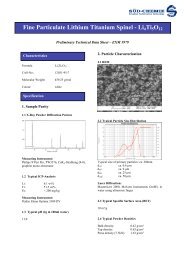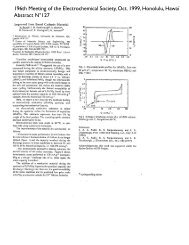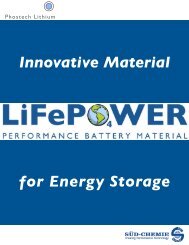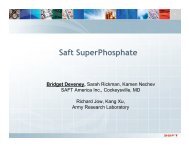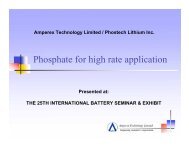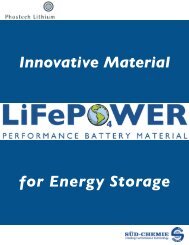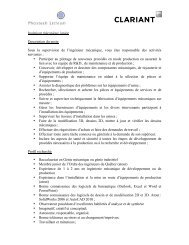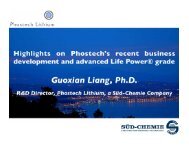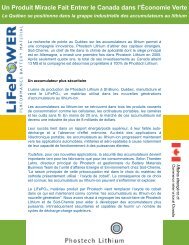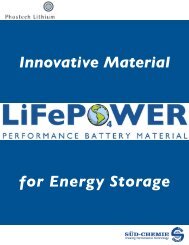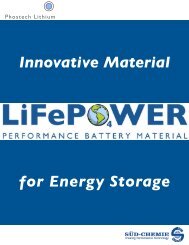Electroactivity of natural and synthetic triphylite - Phostech Lithium inc.
Electroactivity of natural and synthetic triphylite - Phostech Lithium inc.
Electroactivity of natural and synthetic triphylite - Phostech Lithium inc.
- No tags were found...
You also want an ePaper? Increase the reach of your titles
YUMPU automatically turns print PDFs into web optimized ePapers that Google loves.
N. Ravet et al. / Journal <strong>of</strong> Power Sources 97±98 2001) 503±507 505<br />
Electronically conductive coatings were obtained for<br />
classical <strong>and</strong> <strong>natural</strong> LiFePO 4 , from the decomposition<br />
<strong>of</strong> organic substances. We report here results obtained with<br />
sucrose, cellulose acetate <strong>and</strong> a modi®ed polycyclic. The<br />
<strong>triphylite</strong> powder was mixed with a solution <strong>of</strong> the above<br />
carbon precursors thereafter named organic substances).<br />
The dry additive corresponds to 5% <strong>of</strong> the <strong>triphylite</strong><br />
weight. After drying, blends are submitted to heat treatment<br />
at 7008C under argon atmosphere for 4 h. The<br />
quantity <strong>of</strong> carbon-coated represents about 1% in weight<br />
<strong>of</strong> the material.<br />
The electrochemical investigations were made in lithium<br />
batteries with a polyethylene oxide) PEO) bistri¯uoromethanesulfonimide<br />
lithium salt LiTFSI) as<br />
electrolyte with a ratio O/Li <strong>of</strong> 20. Composite cathodes<br />
were made <strong>of</strong> electroactive material, ketjen black, PEO in<br />
the proportions 33.8; 9.5; 56.7 by weight, acetonitrile was<br />
added to dissolve the PEO. These components were intimately<br />
mixed together <strong>and</strong> spread on a stainless steal<br />
current collector 1.7 cm 2 ). Investigations were performed<br />
at 808C.<br />
4. Results <strong>and</strong> discussion<br />
Different color powders results <strong>of</strong> ores grinding. The<br />
sample from Maine is beige, the one from Palermo is gray<br />
<strong>and</strong> an intense blue-green color was observed for the powder<br />
originating from Dakota. The <strong>synthetic</strong> material is very pale<br />
green.<br />
The shape <strong>of</strong> the three <strong>natural</strong> powders was observed by<br />
scanning electronic microscopy. In all cases, it contains<br />
small micro-particles <strong>and</strong> some huge massive grains having<br />
excaped the grinding process, with sizes up to 50 mm.<br />
Unfortunately, the <strong>triphylite</strong> content <strong>of</strong> ores was<br />
unknown.<br />
The chemical composition <strong>of</strong> the investigated materials is<br />
summarized in Table 1. The detection limit <strong>of</strong> elements<br />
corresponds to 1% by weight <strong>of</strong> the solid. The maximal<br />
purity given in the Table 1 was calculated considering that<br />
only the <strong>triphylite</strong> phase contains the element which presents<br />
the highest departure from the stoichiometry lithium for<br />
<strong>synthetic</strong> <strong>and</strong> Dakota <strong>triphylite</strong>, iron <strong>and</strong> manganese for<br />
Maine <strong>and</strong> Palermo samples). This is a maximum purity<br />
Fig. 2. Tenth voltammetric scans a); evolution <strong>of</strong> the discharge capacity upon cycling b) for carbon-coated <strong>natural</strong> <strong>and</strong> <strong>synthetic</strong> <strong>triphylite</strong> samples. Results<br />
obtained by cyclic valtammetry scan rate 20 mV h 1 ; temperature 808C; electrolyte PEO±Li salt O/Li ˆ 20/1).



